Ijraset Journal For Research in Applied Science and Engineering Technology
- Home / Ijraset
- On This Page
- Abstract
- Introduction
- Conclusion
- References
- Copyright
WiFi-Tally: Crowd Monitoring and Counting
Authors: Anushka Tiwari, Arpit Srivastava, Deepesh Attri, Rajeev Pandey
DOI Link: https://doi.org/10.22214/ijraset.2024.62470
Certificate: View Certificate
Abstract
WiFiTally is a technology tool designed to use Wi-Fi signals to track and count people in public places. Imagine having a system that can track and detect people\'s movements in areas such as shopping malls, airports, and cinemas without compromising privacy. WiFiTally does this by using Wi-Fi signals emitted by smartphones and other connected devices that people carry. Simply WiFiTally analyzes the Wi-Fi signal pattern in a designated area to gain insight into crowding and movement. The technology prioritizes privacy by using Wi-Fi signals that people want to leave on their devices, rather than relying on traditional methods like cameras. The process involves collecting anonymous data from Wi-Fi signals and turning it into useful data about population size and traffic. It does not identify individuals; instead, it focuses on all topics to help businesses and theater organizations make informed decisions about crowd management. WiFiTally offers non-interference and privacy solutions to understand and optimize audiences. This brief aims to introduce the concept of WiFiTally monitoring and crowd counting, highlighting ease of use and respect for privacy in public spaces.
Introduction
I. INTRODUCTION
Counting people and determining their walking speed and direction may have applications in many areas. For example, in a smart home, lighting, heating and cooling can be controlled depending on the number of people in the room. In retail, consumption and preferences can be determined by the number of people and the time spent in an area. Passenger traffic and traffic in public areas such as subways, bus terminals and train stations can be controlled and reported according to the number of people. Traditional census methods, including manual counting or infrared imaging, are time-consuming, expensive and sometimes impractical, especially in densely populated areas. Optical imaging with machine learning capability has been introduced and used in many cases [1, 2, 3, 4]. However, the image-based method has some disadvantages, such as the performance of optical equipment, the possibility of large blind spots, and low accuracy, and exists in complex environments due to the consistency of various objects and occlusion targets. Radio-based calculations followed. Some radio systems require humans to carry electronic devices that emit radio frequency (RF) signals to operate and extract data [5, 6, 7]; They are often inconvenient and cannot be used. Another way radio is passive: They don't require users to carry the device, but they do need to deploy early wireless sensor networks, which used to be very expensive and difficult to operate. Wireless communications for mobile communications and the Internet have become increasingly popular in recent years. Most homes and offices have Wi-Fi routers and signals. Wi-Fi signals go everywhere and are affected or scattered by objects and people. Therefore, they carry information about people and their environment and can be used to make decisions and analyze people's behavior and activities. For example, they can be used to recognize different human poses and gestures [8, 9, 10, 11, 12], identify people [13, 14], recognize statues [15], and track the position of people and objects. animals[16,17]. They can also estimate a person's breathing frequency by analyzing the modulation and phase changes of the Wi-Fi signal channel information state (CSI) [ 18, 19, 20, 21, 22 ].
Some methods of using WiFi signals have been developed, including by humans (the content of this article). Seefelding M et al. He proposed the Nuzzer system [23]. The system uses the difference in received Wi-Fi signal strength to estimate the number of people. Xi et al. proposed FCC system [24]. The system analyzes the relationship between personnel in a particular area and the situational information (CSI) it receives. It measures the percentage of non-zero points in the CSI matrix. Then use gray model theory to connect the percentage and people, get the growth curve, and count people [25]. De Patra et al. Describe the loss of absorption and the many consequences resulting from human physical disabilities and emotions [26]. They then developed a mathematical model to predict people. Fadel Adib and Dina Katabi [27] used the inverse synthetic aperture radar principle and used various techniques and various interference devices to eliminate the interference problem of fixed targets. They then proposed a method that could detect moving targets and estimate their numbers. Yang et al. proposed the first gate monitoring by analyzing the WiFi signal [28].
However, all these methods require training with prior knowledge of teaching materials that may not be available or possible. For this purpose, we want people to find a way based on the Wi-Fi signal. This way does not require any training data and only needs to have a design in advance. Wi-Fi signals can also estimate a person's speed.
The main contributions of this paper are summarized as follows:
- A dual-threshold method is proposed to detect the beginning and end of entry time or exiting the room. It overcomes the inaccuracy and expensive problems associated with manual and sliding range techniques as described in [29].
- A method for estimating human walking speed using non-linear curve fitting techniques.
- A search method has been established to determine whether people have entered the room. Unlike deep learning algorithms, such as the gate tracking method proposed in [28], this method does not require training data, but requires building models first.
- A different method has been proposed to determine the entrance or exit. It exploits the difference between signal variances inside and outside the room, a feature that has not been investigated or reported in the literature thus far. It enables simple communication requiring only one antenna (unlike the dual antenna approach proposed in [28]).
II. MATERIALS AND METHODS
Figure 1 is a general diagram of the proposed method. This is considered a room with a door through which people enter and exit the room. The wireless router is inside the room and placed near the door. List the subcarriers on the Wi-Fi router and select one of them for further operations. Filters are used to remove outliers for selected subcarriers. A threshold is used to determine the start and end time of entering or leaving the room through the door. Dynamic Time Rule (DTW) algorithms are used to compare and analyze the observed signal with previously generated data. Then determine how many people came to the door. After this, different methods are used to determine whether the person has entered or not. If it is a person, the speed is also estimated.

Mainstream Wi-Fi systems use 802.11 a/g/n and use orthogonal frequency division multiplexing (OFDM). It divides the 20 MHz bandwidth into 56 subcarrier bands. Subcarriers carry state information (CSI) in amplitude and phase. When encountering objects, these carriers have different wavelengths, causing the multipath signal to spread and attenuate; They result in obtaining features related to CSI amplitude and phase shift. Data transfer can be used and processed for product discovery. So a Wi-Fi router and a signal in the room are used to identify and count people entering and exiting the door. We will describe the proposed methods in the following subsections.
A. Subcarrier Selection and filtEring
In the proposed algorithm, we select the subcarrier with the largest variance to be detected. Since the shift number is the largest, the selected subcarrier is more sensitive to changes in CSI than other subcarriers. In the case we are considering, the frequency response of the subcarrier can be expressed as follows:

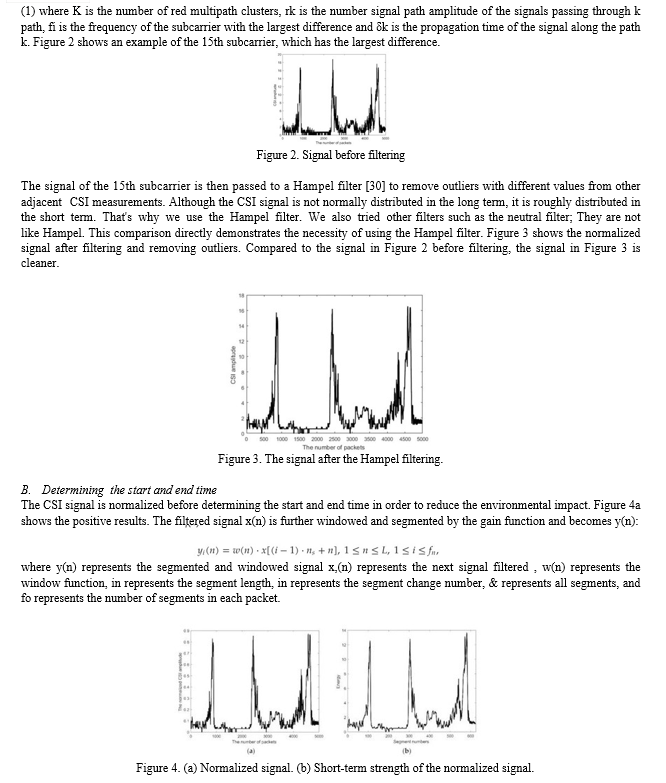
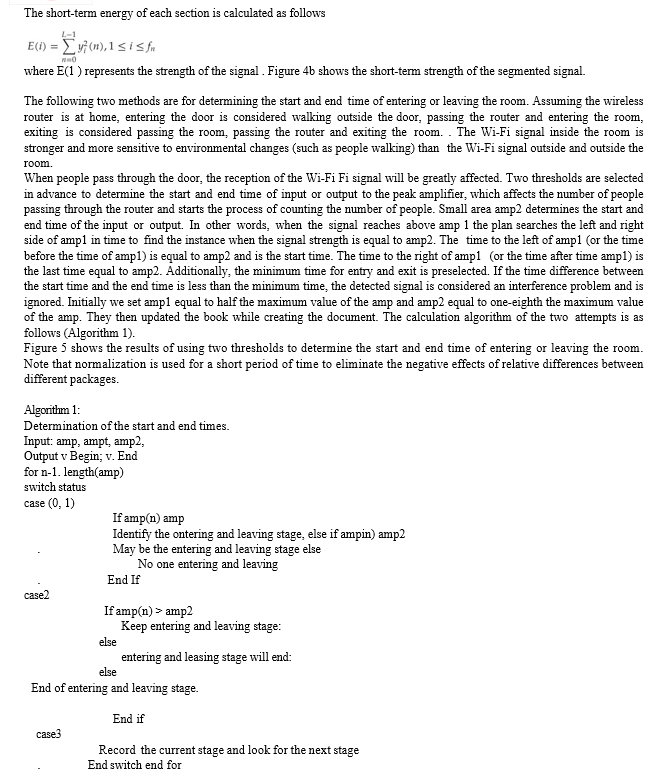
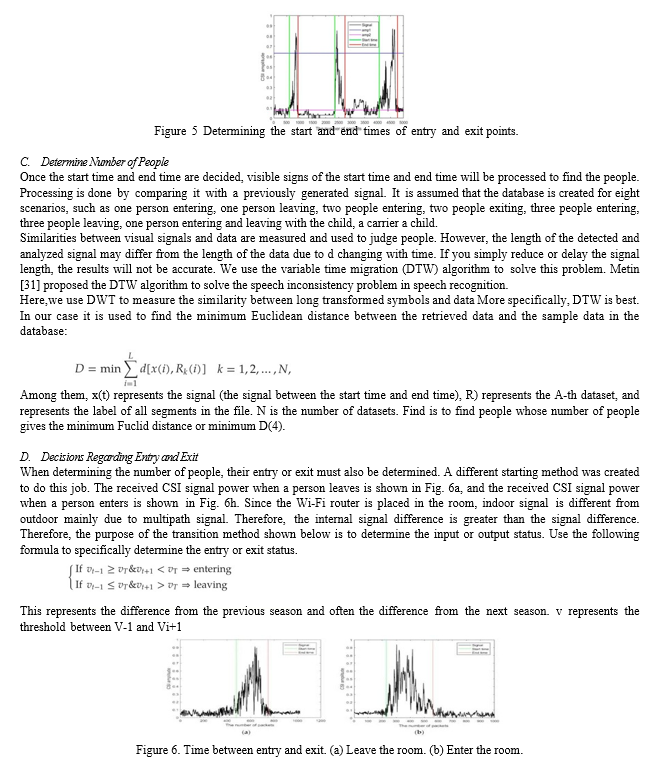
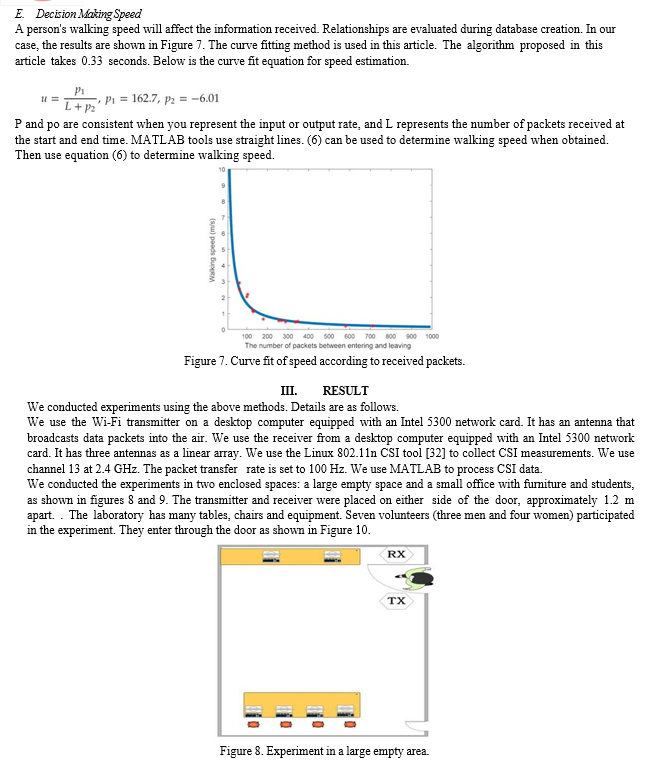

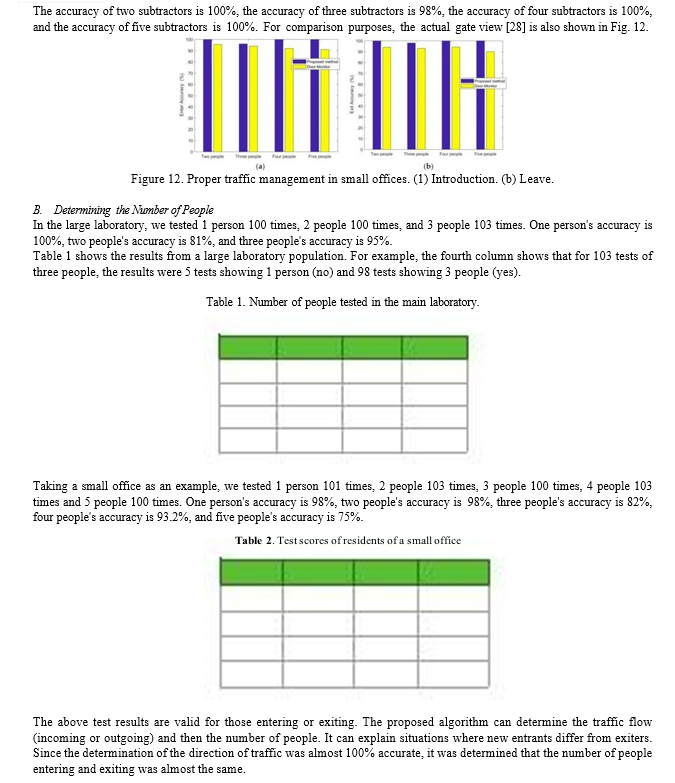
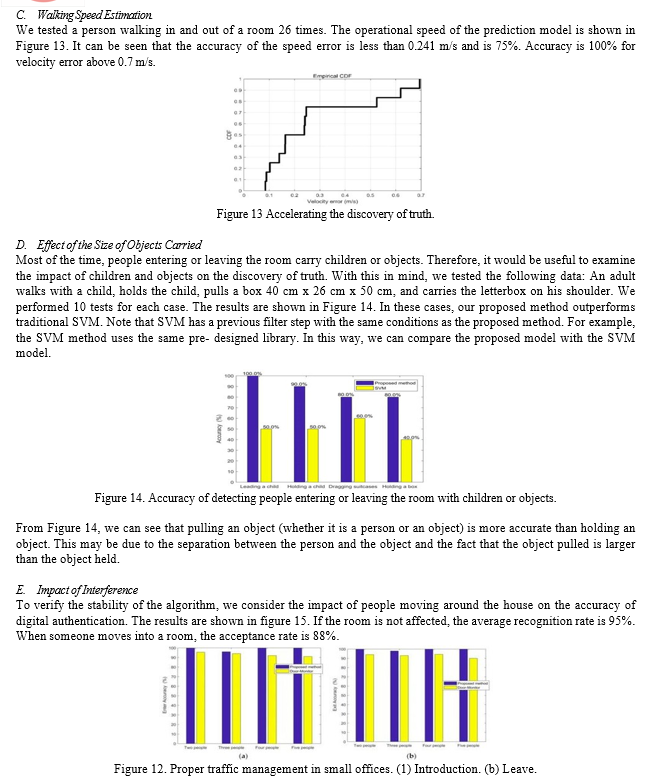
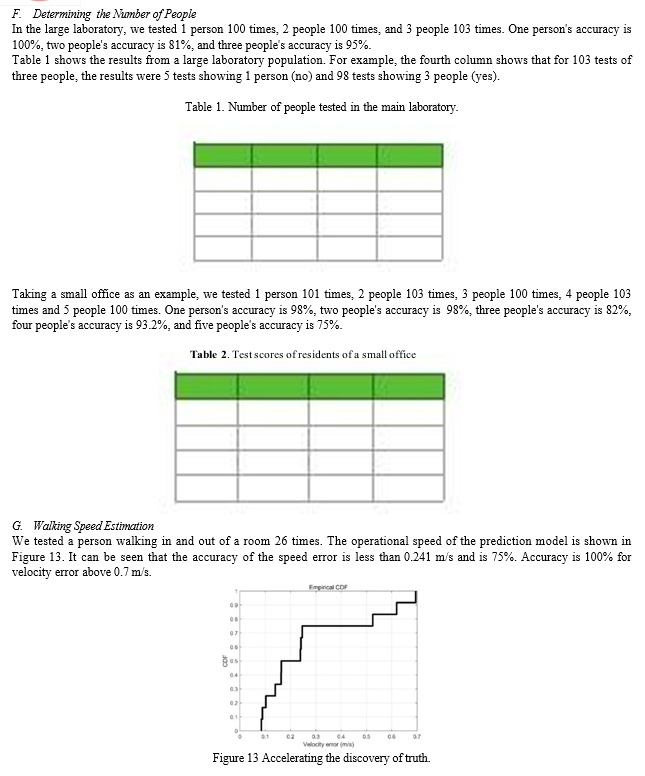
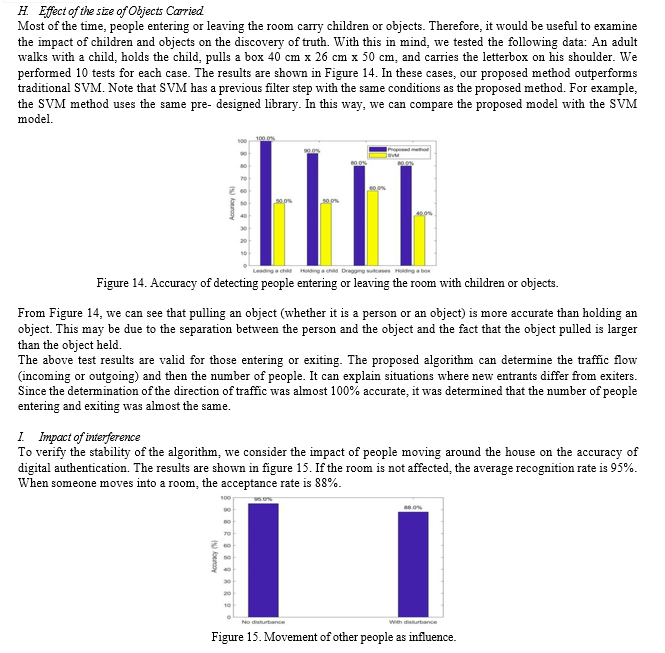
Conclusion
Counting the number of people entering and leaving a room provides important information for human traffic management and flow analysis. Few papers have used CSI signals to estimate the number of people entering and leaving a room. We found only one relevant article published so far [28]. It uses a deep learning approach and requires training with large amounts of data. Our method does not need training. It only requires a pre-developed sample database. In addition, at least two receiving antennas are used in [28] with higher cost and complexity. However, the proposed method only needs one receiving antenna. It also calculates walking speed. Experiments show that in a large, empty laboratory, the accuracy rates for determining the number of people are 100% for one person, 81% for two people, and 95% for three people. In a small office, the number detection accuracy is 98% for one or two people, 82% for three people, 93% for four people, and 75% for five people. For walking speed estimation, the accuracy rate for a speed error of less than 0.2410 m/s is 75% for a single person. A group of five people can be considered a reasonably extreme case given the size of the door. If more than five people enter or exit the door and they are close to each other, the proposed method will present the result of five people. If they are not close to each other, the proposed method counts them separately. The proposed algorithm is at the stage of laboratory research and is not yet ready for real use. However, the ultimate goal is to get it ready for real use and built into a Wi-Fi router - this paper is the first step to developing and validating the algorithm. Its real-time implementation and the counting of multiple persons entering and leaving simultaneously are topics for future research.
References
[1] Kim, M.; Kim, W.; Kim, C. Estimating the range of human beings in crowded scenes by using MID based foreground segmentation and head-shoulder detection. In complaints of the nineteenth global conference on pattern reputation, Tampa, FL, usa, 8–12 December 2008; pp. 1–four. [Google Scholar] [2] Chan, A.B.; Liang, Z.-S.J.; Vasconcelos, N. privateness preserving crowd monitoring: Counting human beings with out human beings fashions or monitoring. In lawsuits of the 2008 IEEE conference on pc imaginative and prescient and pattern recognition, Anchorage, AK, united states of america, 23–28 June 2008; pp. 1–7. [Google Scholar] [3] Idrees, H.; Saleemi, I.; Seibert, C.; Shah, M. Multi-supply Multi- scale Counting in extremely Dense Crowd pix. In court cases of the 2013 IEEE conference on computer imaginative and prescient and sample recognition, Portland, OR, america, 23–28 June 2013; pp. 2547–2554. [Google Scholar] [4] Subburaman, V.B.; Descamps, A.; Carincotte, C. Counting people within the Crowd the usage of a regular Head Detector. In court cases of the 2012 IEEE ninth worldwide convention on superior Video and sign-based Surveillance, Beijing, China, 18– 21 September 2012; pp. 470–475. [Google Scholar] [5] Kannan, P.G.; Venkatagiri, S.P.; Chan, M.C.; Ananda, A.L.; Peh, L.-S. Low fee crowd counting the use of audio tones. In proceedings of the tenth ACM convention on Recommender structures, Toronto, ON, Canada, 6–9 November 2012; pp. a hundred and fifty five–168. [Google Scholar] [6] Weppner, J.; Lukowicz, P. Bluetooth based totally collaborative crowd density estimation with cellular phones. In complaints of the 2013 IEEE worldwide convention on Pervasive Computing and Communications (PerCom), San Diego, CA, america, 18– 22 March 2013; pp. 193–two hundred. [Google Scholar] [7] Ni, L.M.; Liu, Y.; Lau, Y.C.; Patil, A.P. LANDMARC: Indoor area sensing the use of energetic RFID. In court cases of the primary IEEE worldwide conference on Pervasive Computing and Communications, citadel well worth, TX, united states of america, 26 March 2003; pp. 407–415. [Google Scholar] [8] Zheng, X.; Wang, J.; Shangguan, L.; Zhou, Z.; Liu, Y. Smokey: Ubiquitous smoking detection with commercial WiFi infrastructures. In court cases of the IEEE INFOCOM 2016— The 35th Annual IEEE international conference on pc Communications, San Francisco, CA, america, 10–14 April 2016; pp. 1–9. [Google Scholar] [9] Duan, S.; Yu, T.; He, J. WiDriver: driving force hobby popularity system based totally on WiFi CSI. Int. J. Wirel. Inf. Netw. 2018, 25, 146–156. [Google Scholar] [CrossRef] [10] Feng, C.; Arshad, S.; Liu, Y. MAIS: multiple interest identification machine using channel country data of WiFi alerts. In Transactions on Petri Nets and other fashions of Concurrency XV; Springer technological know-how and business Media LLC: Cham, Switzerland, 2017; pp. 419–432. [Google Scholar] [11] Guo, L.; Wang, L.; Liu, J.; Zhou, W.; Lu, B. HuAc: Human pastime popularity the use of Crowdsourced WiFi signals and Skeleton data. Wirel. Commun. Mob. Comput. 2018, 2018, 6163475. [Google Scholar] [CrossRef] [12] Jiang, W.; Miao, C.; Ma, F.; Yao, S.; Wang, Y.; Yuan, Y.; Xue, H.; song, C.; Ma, X.; Koutsonikolas, D.; et al. in the direction of surroundings impartial device loose Human activity reputation. In proceedings of the 24th Annual worldwide conference on cellular Computing and Networking, New Delhi, India, 29 October–2 November 2018; pp. 289–304. [Google Scholar] [13] Zhang, J.; Wei, B.; Hu, W.; Kanhere, S.S. WiFi-identification: Human identity the use of WiFi signal. In complaints of the 2016 worldwide conference on dispensed Computing in Sensor structures (DCOSS), Washington, DC, usa, 26–25 may 2016; pp. 75–eighty two. [Google Scholar] [14] Zeng, Y.; Pathak, P.H.; Mohapatra, P. WiWho: WiFi-based character identity in clever areas. In proceedings of the 2016 15th ACM/IEEE worldwide conference on records Processing in Sensor Networks (IPSN), Vienna, Austria, 28 April 2016; pp. 1–12. [Google Scholar] [15] Ali, k.; Liu, A.X.; Wang, W.; Shahzad, M. Keystroke recognition the use of WiFi signals. In complaints of the twenty first Annual international convention on mobile Computing and Networking, Paris, France, 7–11 September 2015; pp. ninety–102. [Google Scholar] [16] Kotaru, M.; Joshi, ok.; Bharadia, D.; Katti, S. SpotFi: Decimeter level localization the usage of WiFi. In complaints of the ACM SIGCOMM pc communication evaluate, London, united kingdom, 17–21 August 2015; quantity forty five, pp. 269–282. [Google Scholar] [17] Xu, C.; Firner, B.; Moore, R.S.; Zhang, Y.; Trappe, W.; Howard, R.; Zhang, F.; An, N. Scpl: Indoor device-unfastened multi-issue counting and localization using radio signal energy. In lawsuits of the 2013 ACM/IEEE international convention on facts Processing in Sensor Networks (IPSN), Philadelphia, PA, usa, eight–11 April 2013; pp. 79–ninety. [Google Scholar] Wang, X.; Yang, C.; Mao, S. PhaseBeat: Exploiting CSI phase data for vital sign tracking with Commodity WiFi gadgets. In proceedings of the 2017 IEEE thirty seventh worldwide conference on disbursed Computing structures (ICDCS), Atlanta, GA, u.s., five–eight June 2017; pp. 1230–1239. [Google Scholar] [18] Liu, J.; Chen, Y.; Wang, Y.; Chen, X.; Cheng, J.; Yang, J. tracking vital symptoms and Postures at some point of Sleep the use of WiFi signals. IEEE internet matters J. 2018, five, 2071– 2084. [Google Scholar] [CrossRef] [19] Wang, H.; Zhang, D.; Ma, J.; Wang, Y.; Wang, Y.; Wu, D.; Gu, T.; Xie, B. Human respiration detection with Commodity WiFi devices: Do user vicinity and frame orientation count number? In complaints of the 2016 ACM international Joint convention on Pervasive and Ubiquitous Computing (UbiComp 2016), Heidelberg, Germany, 12–sixteen September 2016; pp. 25–36. [Google Scholar] [20] Zhang, D.; Hu, Y.; Chen, Y.; Zeng, B. BreathTrack: tracking Indoor Human Breath fame thru Commodity WiFi. IEEE internet matters J. 2019, 6, 3899–3911. [Google Scholar] [CrossRef] [21] Lee, S.; Park, Y.-D.; Suh, Y.-J.; Jeon, S. layout and implementation of tracking machine for respiration and coronary heart fee sample using WiFi indicators. In proceedings of the 2018 15th IEEE Annual purchaser Communications & Networking convention (CCNC), Las Vegas, NV, u.s., 12–15 January 2018; pp. 1–7. [Google Scholar] [22] Seifeldin, M.; Saeed, A.; Kosba, A.E.; El-Keyi, A.; Youssef, M. Nuzzer: A massive-Scale tool-free Passive Localization system for wi-fi Environments. IEEE Trans. Mob. Comput. 2013, 12, 1321–1334. [Google Scholar] [CrossRef] [Green Version] [23] Xi, W.; Zhao, J.; Li, X.-Y.; Zhao, ok.; Tang, S.; Liu, X.; Jiang, Z. electronic frog eye: Counting crowd using WiFi. In court cases of the IEEE INFOCOM 2014—IEEE conference on pc Communications, Toronto, ON, Canada, 27 April–2 may additionally 2014; pp. 361–369. [Google Scholar] [24] Liu, S.; Lin, Y. gray facts: principle and sensible packages; Springer science & business Media: Berlin, Germany, 2006; volume 37, p. 189. [Google Scholar] [25] Depatla, S.; Muralidharan, A.; Mostofi, Y. Mostofi Occupancy estimation using simplest WiFi energy measurements. IEEE J. Sel. regions Commun. 2015, 33, 1381–1393. [Google Scholar] [CrossRef]
Copyright
Copyright © 2024 Anushka Tiwari, Arpit Srivastava, Deepesh Attri, Rajeev Pandey . This is an open access article distributed under the Creative Commons Attribution License, which permits unrestricted use, distribution, and reproduction in any medium, provided the original work is properly cited.

Download Paper
Paper Id : IJRASET62470
Publish Date : 2024-05-21
ISSN : 2321-9653
Publisher Name : IJRASET
DOI Link : Click Here
 Submit Paper Online
Submit Paper Online

